inflation pressure LEXUS RCF 2021 Owners Manual
[x] Cancel search | Manufacturer: LEXUS, Model Year: 2021, Model line: RCF, Model: LEXUS RCF 2021Pages: 408, PDF Size: 8.25 MB
Page 1 of 408

RCF_U
1
2
3
4
5
6
7
8
9
Pictorial indexSearch by illustration
For safety
and securityMake sure to read through them
(Main topics: Child seat, theft deterrent system)
Vehicle status
information and
indicatorsReading driving-related information
(Main topics: Meters, multi-information display)
Before drivingOpening and closing the doors and windows,
adjustment before driving
(Main topics: Keys, doors, seats)
DrivingOperations and advice which are necessary for driving
(Main topics: Starting engine, refueling)
Interior featuresUsage of the interior features
(Main topics: Air conditioner, storage features)
Maintenance
and careCaring for your vehicle and maintenance procedures
(Main topics: Interior and exterior, light bulbs)
When trouble
arisesWhat to do in case of malfunction and emergency
(Main topics: Battery discharge, flat tire)
Vehicle
specificationsVehicle specifications, customizable features
(Main topics: Fuel, oil, tire inflation pressure)
For ownersReporting safety defects for U.S. owners, and seat belt,
SRS airbag and headlight aim instructions for Canadian
owners
IndexSearch by symptom
Search alphabetically
Page 4 of 408

4TABLE OF CONTENTS
Hood..................................................264
Positioning a floor jack............... 265
Engine compartment.................. 267
Tires ................................................... 273
Tire inflation pressure ................. 279
Wheels............................................... 281
Air conditioning filter..................282
Electronic key battery ................ 283
Checking and replacing fuses ........................................................... 285
Headlight aim................................. 287
Light bulbs ....................................... 288
7-1. Essential information Emergency flashers..................... 294
If your vehicle has to be stopped in an emergency ............................. 294
If the vehicle is trapped in rising water............................................... 295
7-2. Steps to take in an emergency If your vehicle needs to be towed........................................................... 297
If you think something is wrong ........................................................... 300
Fuel pump shut off system ......... 301
If a warning light turns on or a warn- ing buzzer sounds ..................... 302
If a warning message is displayed ............................................................ 310
If you have a flat tire (vehicles with a spare tire) ...................................... 313
If you have a flat tire (vehicles with an emergency tire puncture
repair kit) ....................................... 319
If the engine wi ll not start .......... 329If you lose your keys.....................
331
If the fuel filler door cannot be opened ........................................... 331
If the electronic key does not oper- ate properly ................................. 332
If the vehicle battery is discharged .......................................................... 334
If your vehicle overheats ........... 337
If the vehicle becomes stuck ... 339
8-1. Specifications Maintenance data (fuel, oil level, etc.) ................................................. 342
Fuel information............................ 349
Tire information ............................. 351
8-2. Customization Customizable features .............. 360
8-3. Items to initialize Items to initialize ........................... 369
8-4. Certifications Certifications ................................. 370
9-1. For owners Reporting safety defects for U.S. owners ........................................... 380
Seat belt instructions for Canadian owners (in French) ................... 380
SRS airbag instructions for Cana- dian owners (in French) ......... 382
Headlight aim instructions for Canadian owners (in French)... .......
................................................ 388
7When trouble arises
8Vehicle specifications
9For owners
Page 13 of 408
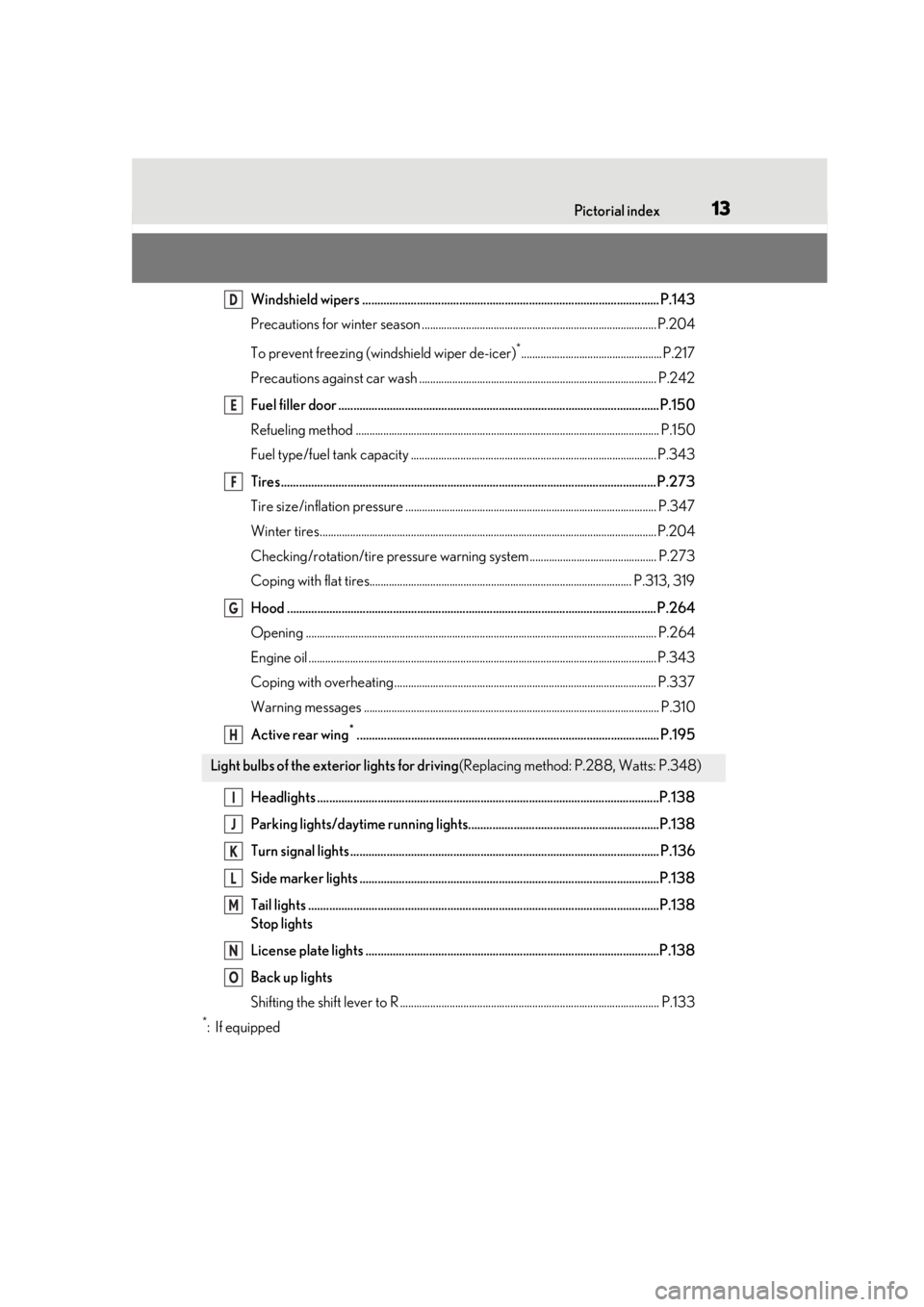
13Pictorial index
Windshield wipers .................................................................................................. P.143
Precautions for winter season ..................................................................................... P.204
To prevent freezing (windshield wiper de-icer)
*................................................... P.217
Precautions against car wash ............................. ......................................................... P.242
Fuel filler door ..........................................................................................................P.150
Refueling method .............................................................................................................. P .150
Fuel type/fuel tank capacity ...... ................................................................................... P.343
Tires.......................................................................................................................... ..P.273
Tire size/inflation pressure ............................ ............................................................... P.347
Winter tires.......................................................................................................................... P.204
Checking/rotation/tire pressure warning system.............................................. P.273
Coping with flat tires............................................................................................... P.313, 319
Hood .......................................................................................................................... P.264
Opening ........................................................................................................................ ....... P.264
Engine oil ..................................................................................................................... ......... P.343
Coping with overheating ............................................................................................... P.337
Warning messages ........................................................................................................... P.31 0
Active rear wing
*.................................................................................................... P.195
Headlights .................................................................................................................P.13 8
Parking lights/daytime running lights...............................................................P.138
Turn signal lights ...................................................................................................... P.136
Side marker lights ...................................................................................................P.138
Tail lights .................................................................................................................... P.138
Stop lights
License plate lights .................................................................................................P.138
Back up lights
Shifting the shift lever to R .............................................................................................. P.13 3
*:If equipped
Light bulbs of the exterior lights for driving(Replacing method: P.288, Watts: P.348)
D
E
F
G
H
I
J
K
L
M
N
O
Page 77 of 408
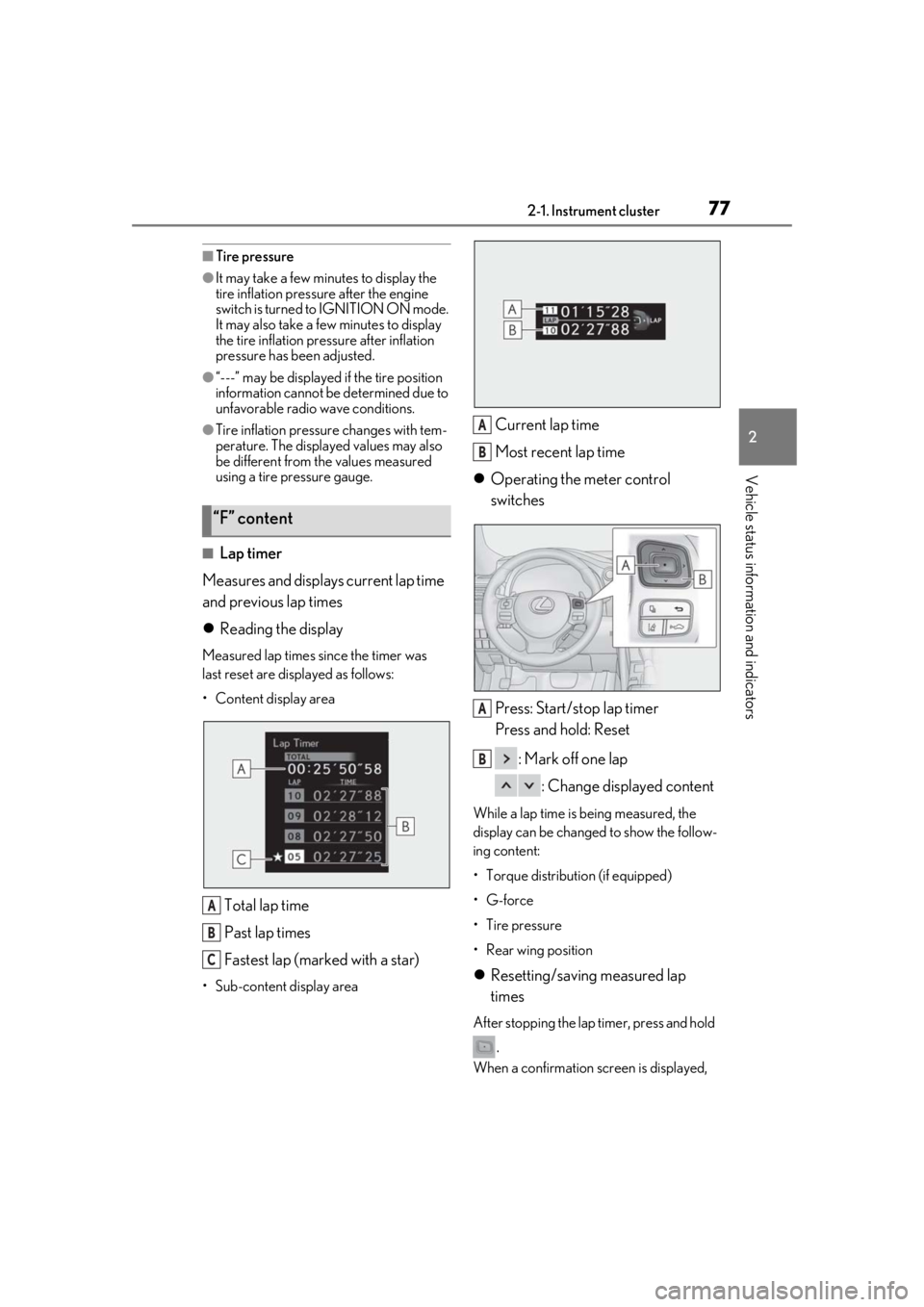
772-1. Instrument cluster
2
Vehicle status information and indicators
■Tire pressure
●It may take a few minutes to display the
tire inflation pressure after the engine
switch is turned to IGNITION ON mode.
It may also take a few minutes to display
the tire inflation pressure after inflation
pressure has been adjusted.
●“---” may be displayed if the tire position
information cannot be determined due to
unfavorable radio wave conditions.
●Tire inflation pressure changes with tem-
perature. The displayed values may also
be different from the values measured
using a tire pressure gauge.
■Lap timer
Measures and displays current lap time
and previous lap times
Reading the display
Measured lap times since the timer was
last reset are displayed as follows:
•Content display area
Total lap time
Past lap times
Fastest lap (marked with a star)
•Sub-content display area
Current lap time
Most recent lap time
Operating the meter control
switches
Press: Start/stop lap timer
Press and hold: Reset : Mark off one lap: Change displayed content
While a lap time is being measured, the
display can be changed to show the follow-
ing content:
• Torque distribution (if equipped)
•G-force
• Tire pressure
•Rear wing position
Resetting/saving measured lap
times
After stopping the lap timer, press and hold
.
When a confirmation screen is displayed,
“F” content
A
B
C
A
B
A
B
Page 163 of 408

1634-5. Using the driving support systems
4
Driving
• The vehicle is wobbling.
• The vehicle is being driven at extremely high speeds.
• When driving on a hill
• If the radar sensor or front camera is mis- aligned
●In some situations such as the following,
sufficient braking force may not be
obtained, preventing the system from
performing properly:
• If the braking functions cannot operate to
their full extent, such as when the brake
parts are extremely cold, extremely hot,
or wet
• If the vehicle is not properly maintained (brakes or tires are excessively worn,
improper tire inflation pressure, etc.)
• When the vehicle is being driven on a gravel road or other slippery surface
●Some pedestrians such as the following
may not be detected by the radar sensor
and front camera, preventing the system
from operating properly:
• Pedestrians shorter than approximately 3.2 ft. (1 m) or tall er than approximately
6.5 ft. (2 m)
• Pedestrians wearing oversized clothing (a rain coat, long skirt, etc.), making their
silhouette obscure
• Pedestrians who are carrying large bag- gage, holding an umbrella, etc., hiding
part of their body
• Pedestrians who are bending forward or squatting
• Pedestrians who are pushing a stroller, wheelchair, bicycle or other vehicle
• Groups of pedestrians which are close
together
• Pedestrians who are wearing white and look extremely bright
• Pedestrians in the dark, such as at night or while in a tunnel
• Pedestrians whose clothing appears to
be nearly the same co lor or brightness as
their surroundings
• Pedestrians near walls , fences, guardrails,
or large objects
• Pedestrians who are on a metal object (manhole cover, steel plate, etc.) on the
road
• Pedestrians who are walking fast
• Pedestrians who are changing speed abruptly • Pedestrians running out from behind a
vehicle or a large object
• Pedestrians who are extremely close to
the side of the vehicle (outside rear view
mirror, etc.)
■If VSC is disabled
●If VSC is disabled ( P.199), the pre-col-
lision brake assist and pre-collision brak-
ing functions are also disabled.
●The PCS warning light will turn on and
“VSC Turned Off Pre-Collision Brake
System Unavailable” will be displayed on
the multi-information display.
Page 202 of 408
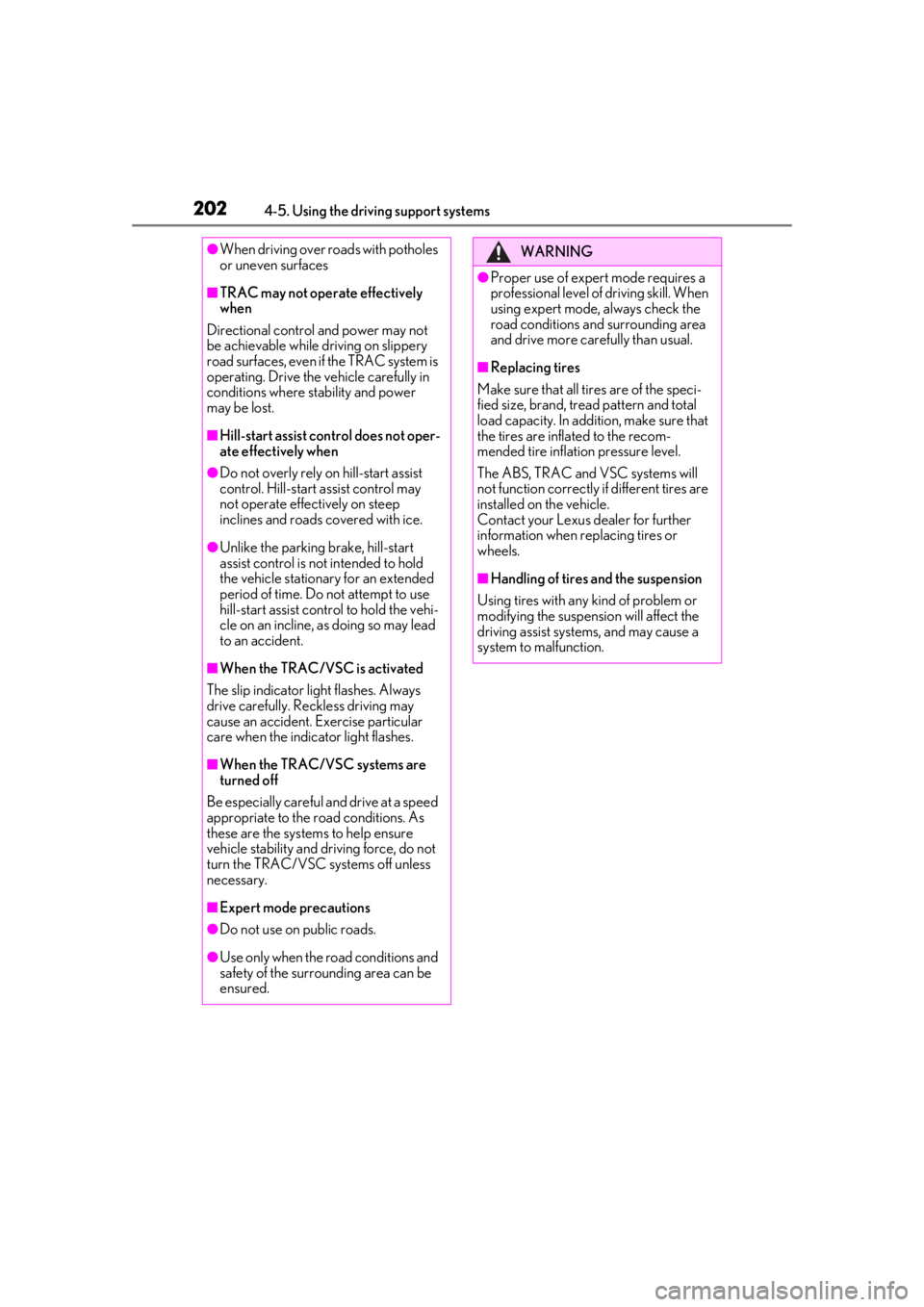
2024-5. Using the driving support systems
●When driving over roads with potholes
or uneven surfaces
■TRAC may not operate effectively
when
Directional control and power may not
be achievable while driving on slippery
road surfaces, even if the TRAC system is
operating. Drive the vehicle carefully in
conditions where stability and power
may be lost.
■Hill-start assist control does not oper-
ate effectively when
●Do not overly rely on hill-start assist
control. Hill-start assist control may
not operate effectively on steep
inclines and roads covered with ice.
●Unlike the parking brake, hill-start
assist control is not intended to hold
the vehicle stationary for an extended
period of time. Do not attempt to use
hill-start assist control to hold the vehi-
cle on an incline, as doing so may lead
to an accident.
■When the TRAC/VSC is activated
The slip indicator light flashes. Always
drive carefully. Re ckless driving may
cause an accident. Exercise particular
care when the indicator light flashes.
■When the TRAC/VSC systems are
turned off
Be especially careful and drive at a speed
appropriate to the road conditions. As
these are the system s to help ensure
vehicle stability and driving force, do not
turn the TRAC/VSC systems off unless
necessary.
■Expert mode precautions
●Do not use on public roads.
●Use only when the road conditions and
safety of the surrounding area can be
ensured.
WARNING
●Proper use of expert mode requires a
professional level of driving skill. When
using expert mode, always check the
road conditions and surrounding area
and drive more carefully than usual.
■Replacing tires
Make sure that all ti res are of the speci-
fied size, brand, tread pattern and total
load capacity. In addition, make sure that
the tires are inflated to the recom-
mended tire inflation pressure level.
The ABS, TRAC and VSC systems will
not function correctly if different tires are
installed on the vehicle.
Contact your Lexus dealer for further
information when replacing tires or
wheels.
■Handling of tires and the suspension
Using tires with any kind of problem or
modifying the suspensi on will affect the
driving assist systems, and may cause a
system to malfunction.
Page 239 of 408

239
6
6
Maintenance and care
Maintenance and care
.6-1. Maintenance and careCleaning and protecting the vehi-cle exterior ................................ 240
Cleaning and protecting the vehi- cle interior ................................. 245
6-2. Matte paint care guide (if equipped)
Basic knowledge about matte clear coat ................................... 248
Washing your vehicle ............. 252
Frequently Asked Questions ........................................................ 254
6-3. Maintenance Maintenance requirements .. 257
General maintenance ............. 258
Emission inspection and mainte- nance (I/M) programs .......... 261
6-4. Do-it-yourself maintenance Do-it-yourself service precautions........................................................ 262
Hood............................................... 264
Positioning a floor jack............ 265
Engine compartment............... 267
Tires ................................................ 273
Tire inflation pressure .............. 279
Wheels............................................ 281
Air conditioning filter...............282
Electronic key battery ............. 283
Checking and replacing fuses ........................................................ 285
Headlight aim.............................. 287Light bulbs....................................
288
Page 260 of 408
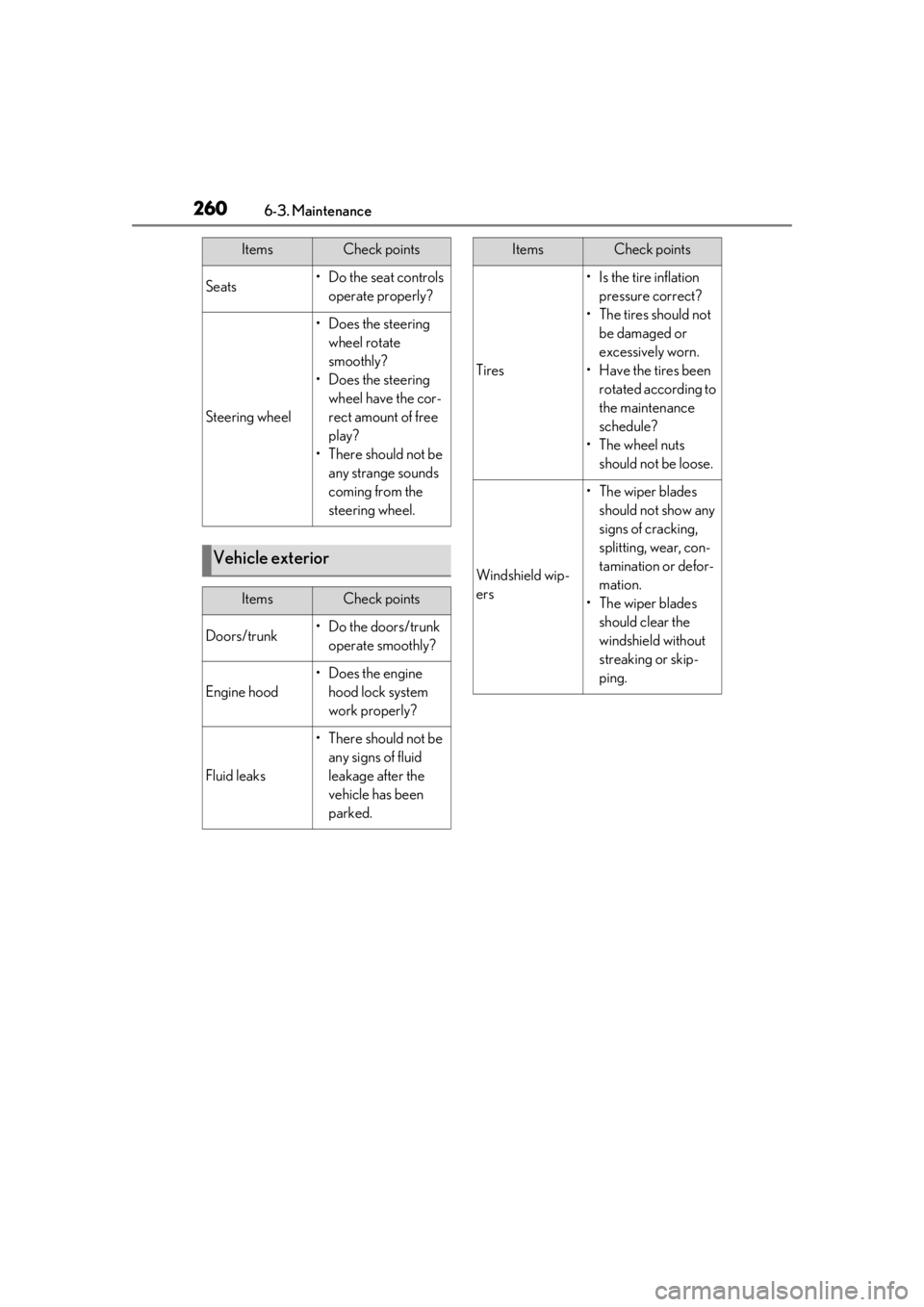
2606-3. Maintenance
Seats• Do the seat controls operate properly?
Steering wheel
• Does the steering wheel rotate
smoothly?
• Does the steering wheel have the cor-
rect amount of free
play?
•There should not be any strange sounds
coming from the
steering wheel.
Vehicle exterior
ItemsCheck points
Doors/trunk• Do the doors/trunk operate smoothly?
Engine hood
•Does the engine hood lock system
work properly?
Fluid leaks
•There should not be any signs of fluid
leakage after the
vehicle has been
parked.
ItemsCheck points
Tires
• Is the tire inflation pressure correct?
• The tires should not be damaged or
excessively worn.
• Have the tires been rotated according to
the maintenance
schedule?
•The wheel nuts should not be loose.
Windshield wip-
ers
• The wiper blades should not show any
signs of cracking,
splitting, wear, con-
tamination or defor-
mation.
• The wiper blades should clear the
windshield without
streaking or skip-
ping.
ItemsCheck points
Page 263 of 408
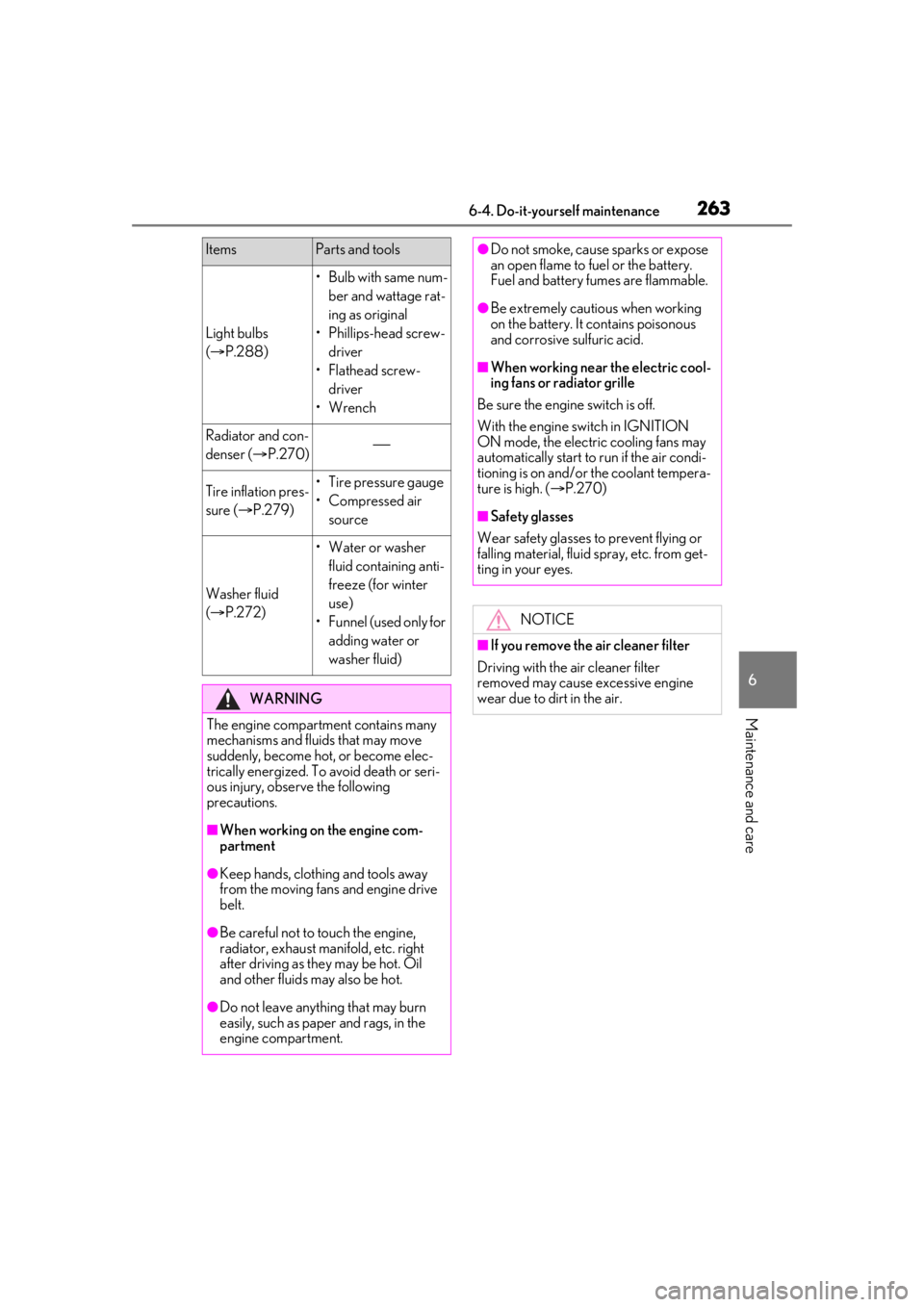
2636-4. Do-it-yourself maintenance
6
Maintenance and care
Light bulbs
( P.288)
•Bulb with same num-
ber and wattage rat-
ing as original
• Phillips-head screw- driver
•Flathead screw- driver
•Wrench
Radiator and con-
denser ( P.270)
Tire inflation pres-
sure ( P.279)• Tire pressure gauge
•Compressed air
source
Washer fluid
( P.272)
• Water or washer
fluid containing anti-
freeze (for winter
use)
• Funnel (used only for adding water or
washer fluid)
WARNING
The engine compartment contains many
mechanisms and fluids that may move
suddenly, become hot, or become elec-
trically energized. To avoid death or seri-
ous injury, observe the following
precautions.
■When working on the engine com-
partment
●Keep hands, clothi ng and tools away
from the moving fans and engine drive
belt.
●Be careful not to touch the engine,
radiator, exhaust manifold, etc. right
after driving as they may be hot. Oil
and other fluids may also be hot.
●Do not leave anything that may burn
easily, such as paper and rags, in the
engine compartment.
ItemsParts and tools●Do not smoke, cause sparks or expose
an open flame to fuel or the battery.
Fuel and battery fumes are flammable.
●Be extremely cautious when working
on the battery. It contains poisonous
and corrosive sulfuric acid.
■When working near the electric cool-
ing fans or radiator grille
Be sure the engine switch is off.
With the engine switch in IGNITION
ON mode, the electric cooling fans may
automatically start to run if the air condi-
tioning is on and/or the coolant tempera-
ture is high. ( P.270)
■Safety glasses
Wear safety glasses to prevent flying or
falling material, fluid spray, etc. from get-
ting in your eyes.
NOTICE
■If you remove the air cleaner filter
Driving with the air cleaner filter
removed may cause excessive engine
wear due to dirt in the air.
Page 274 of 408
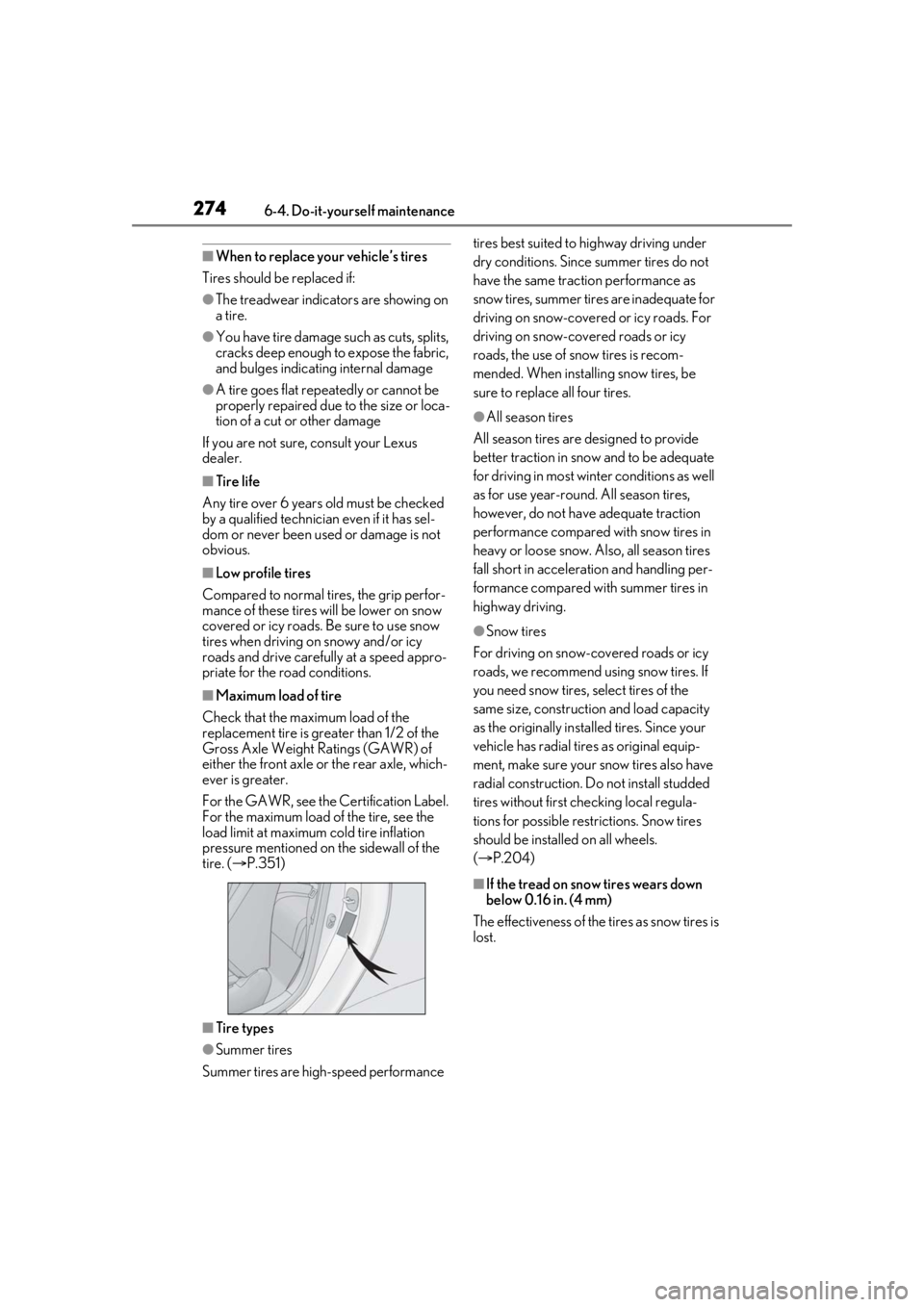
2746-4. Do-it-yourself maintenance
■When to replace your vehicle’s tires
Tires should be replaced if:
●The treadwear indicators are showing on
a tire.
●You have tire damage such as cuts, splits,
cracks deep enough to expose the fabric,
and bulges indicating internal damage
●A tire goes flat repeatedly or cannot be
properly repaired due to the size or loca-
tion of a cut or other damage
If you are not sure, consult your Lexus
dealer.
■Tire life
Any tire over 6 years old must be checked
by a qualified technician even if it has sel-
dom or never been used or damage is not
obvious.
■Low profile tires
Compared to normal tires, the grip perfor-
mance of these tires will be lower on snow
covered or icy roads. Be sure to use snow
tires when driving on snowy and/or icy
roads and drive carefully at a speed appro-
priate for the road conditions.
■Maximum load of tire
Check that the maximum load of the
replacement tire is greater than 1/2 of the
Gross Axle Weight Ratings (GAWR) of
either the front axle or the rear axle, which-
ever is greater.
For the GAWR, see the Certification Label.
For the maximum load of the tire, see the
load limit at maximum cold tire inflation
pressure mentioned on the sidewall of the
tire. ( P.351)
■Tire types
●Summer tires
Summer tires are high-speed performance tires best suited to
highway driving under
dry conditions. Since summer tires do not
have the same traction performance as
snow tires, summer ti res are inadequate for
driving on snow-covered or icy roads. For
driving on snow-covered roads or icy
roads, the use of snow tires is recom-
mended. When installing snow tires, be
sure to replace all four tires.
●All season tires
All season tires are designed to provide
better traction in snow and to be adequate
for driving in most winter conditions as well
as for use year-round. All season tires,
however, do not have adequate traction
performance compared with snow tires in
heavy or loose snow. Also, all season tires
fall short in accelerati on and handling per-
formance compared with summer tires in
highway driving.
●Snow tires
For driving on snow-covered roads or icy
roads, we recommend using snow tires. If
you need snow tires, select tires of the
same size, construction and load capacity
as the originally instal led tires. Since your
vehicle has radial tires as original equip-
ment, make sure your snow tires also have
radial construction. Do not install studded
tires without first checking local regula-
tions for possible restrictions. Snow tires
should be installed on all wheels.
( P.204)
■If the tread on snow tires wears down
below 0.16 in. (4 mm)
The effectiveness of the tires as snow tires is
lost.